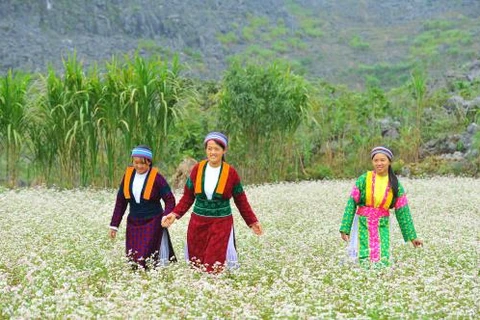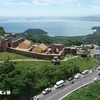 The Lung Cu flagpole that marks the northenmost tip of Vietnam. It is one of the most visited landmarks in the country. (Photo: VNA)
The Lung Cu flagpole that marks the northenmost tip of Vietnam. It is one of the most visited landmarks in the country. (Photo: VNA) Ha Giang (VNS/VNA) – The northernmost province of Ha Giang is beautiful at any time of year, with endless scenery to entertain and inspire visitors. While some travel far and wide across the province, for many Lung Cu flagpole is one milestone not to be missed.
Located at the peak of the Dong Van lime karst plateau, Lung Cu flagpole marks the northernmost tip of Vietnam. It is where Vietnamese living at home or abroad long to visit at least once in their lives.
There have been differing opinions on the source of the name Lung Cu – it can be Long Co meaning a drum with a dragon on it, or Long Cu meaning where dragons live. From a linguist's point of view, the name means ‘Dragon Valley’.
This explanation may fit the geographical structure of the lime karst area, and it follows the legend that today’s Viet people are descendants of the Dragon Father Lac Long Quan and Fairy Mother Au Co.
Lung Cu is located on a plateau between 1,600 and 1,800m above sea level. Nine hamlets in the commune share a 16km border with China. The deep valley of Then Van on the left and the emerald green Nho Que river make for breath-taking views of the area.
In Lung Cu, artefacts from the Hung King era can be found, which date back more than 4,000 years ago. History says that Emperor Quang Trung, during his Tay Son reign (1788-1792), ordered a giant bronze drum to be placed at Lung Cu to announce royal orders. It is now the site of the Lung Cu border patrol station. This could be the reason why Lo Lo people in Lung Cu still use the bronze drums, which originate from the Dong Son era.
This month, Ha Giang made headlines across the country not for its spectacular views and tight mountain turns, but for new constructions at sacred sites. The news sparked concerns they not only destroy the natural scenery, but also the environment.
A vast tourism complex has been under construction for two years. The 75ha project had been reviewed for its environmental impact in 2018, which reserves 70.5ha for the brand new Lung Cu Pagoda and a 4.5ha-site for a giant Buddha statue. Another complex includes 4.8ha for Lung Cu pagoda, nearly 2ha for a Buddhist academy and 9ha for homestays.
The project had applied for and received a licence for the ongoing construction. They even obtained an environmental assessment report from the Ministry of Natural Resources and Environment.
Questioned by the press on whether the project was for the community or for profit, the Phuc Loc group of Ha Giang reportedly told Tuoi Tre newspaper that the company will run the 9ha homestays. “(The company) wanted to build a cultural milestone to protect national sovereignty and also help develop the local economy for a still poor province like Ha Giang."
The culture ministry sent a letter to the Ha Giang People's Committee, saying combining three different types of tourism in one project is not encouraged. These three types of tourism – cultural, religious and eco-tourism are different in nature. According to the letter, Hà Giang has a diverse geological structure, so eco-tourism that involves exploring nature, hiking and trekking to get to know the local life of ethnic minority people is best here.
This viewpoint has also been made clear in the master plan for development of the National Dong Van lime-karst plateau, approved by the Prime Minister in 2017./.
VNA





















